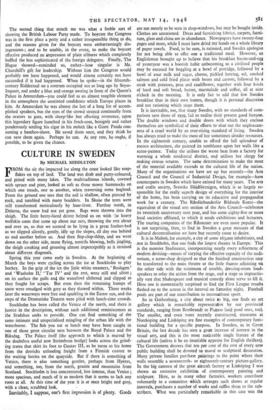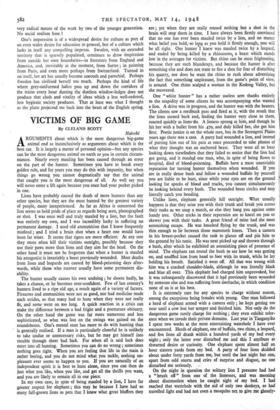CULTURE IN SWEDEN
By MICHAEL MIDDLETON
FROM the air the impacted ice along the coast looked like soap- flakes on top of lard. The land was drab -and putty-coloured, and pitted with many lakes. The multitudinous islands, covered with spruce and pine, looked as soft as those mossy hummocks on which one treads, one to another, when traversing some bogland. From the ground one sees that the soil is shallow, often pierced by rock, and tumbled with many boulders. In Skane the trees were still transformed meticulously by hoar-frost. Further north, in Dalarna, the snow had not yet gone. Bags were thrown into the sleigh. The little berry-faced driver helped us on with :he heavy wolfskin coats that came up about our ears, throwing the rest about and over us, so that we seemed to be lying in a great feather-bed as we slipped silently, gently, idly up the slopes, all day one behind us and another before us. And then flop-clop-thlop, and we went down on the other side, mane flying, nostrils blowing, bells jingling, the sleigh creaking and groaning almost imperceptibly as it strained about different diagonals.
Spring this year came early in Sweden. At the beginning of 'March the boys were cycling across the ice at Stockholm to play hockey. In the grip of the ice the little white steamers, Roslagen' and Waxholm II,' Tor IV ' and the rest, were still and silent ; on its surface the gulls and the waterfowl slithered and slipped as they fought for scraps. But even then the remaining humps of snow were smudged with grey as they thawed within. Three weeks later the waterways were free and sparkling in the Easter sun, and the steps of the Dramatiska Teatern were piled with lunch-time crowds.
Stockholm has been called the Venice of the north, and there is justice in the description, without such additional reminiscences as the Stadshus seeks to provide. One can find something of the same intimate and unspecialised mingling of the urban life with the waterborne. The fish you eat at lunch may have been caught in one of those great circular nets between the Royal Palace and the Riksdag. The Palace itself (the approach to which is marred by the doubtless useful new Strombron bridge) looks across the grind- ing trams that skirt its foot to Gustav III, as he turns to his home from the derricks unloading freight from a Finnish coaster to the waiting lorries on the quayside. But if there is something of Venice, there is also something gentler, perhaps from Hyeres, and something, too, from the north, granite and mountains from Scotland. Stockholm is less concentrated, less intense, than Venice ; more spacious, and much of it so modern that it seems to lack any roots at all. At this time of the year it is at once bright and grey, with a clean, scrubbed look.
Inevitably, I suppose, one's first impression is of plenty. Goods are not merely to be seen in shop-windows, but may be bought inside. Clothes are unrationed. Dress and furnishing fabrics, carpets, furni- ture, glass and china are in abundance. Newspapers have twenty-four pages and more, while I must have dried my hands on a whole library of paper towels. Food, to be sure, is rationed, and Swedes apologise for not being able to offer one a traditional meal. However, an Englishman brought up to believe that his breakfast bacon-and-egg of yesteryear was a boorish habit unbecoming to a civilised people may be excused for boggling at a bowl of porridge, followed by a bowl of sour milk and sugar, cheese, pickled herring, eel, smoked salmon and cold fried plaice with beans and carrots, followed by a steak with potatoes, peas and cauliflower, together with four kinds of hard and soft bread, butter, marmalade and coffee, all at nine o'clock in the morning. It is only fair to add that few Swedes breakfast thus in their own homes, though it is personal discretion and not rationing which stops them.
It is inevitable, too, that many Swedes, with no standards of com- parison save those of 1939, fail to realise their present good fortune. The double windows and double doors with which they enclose themselves are symbolical of their efforts to shut out the unpleasant- ness of a cruel world by an ever-rising standard of living. Sweden has always tried to make the most of her sometimes slender resources. In the eighteenth century, unable to afford the full splendour of rococo architecture, she painted its semblance upon her walls like a scene-painter. Today she utilises the waste heat from a factory for warming a whole residential district, and utilises her clergy for making census returns. The same determination to make the most of the material available extends to the cultural life of the nation. Many of the organisations we have set up but recently—the Arts Council and the Council of Industrial Design, for example—have counterparts in Sweden which have existed for many years. The arts and crafts society, Svenska Slajdforenigen, which is so largely re- sponsible for the really superb design of everything for the interior of the home, has been carrying on its educative and propagandist work for a century. The Riksforbundetfor Bildande Konst—the equivalent of the visual arts section of the Arts Council—celebrates its twentieth anniversary next year, and has some eighty-five or more local societies affiliated, to which it sends exhibitions and lecturers. The touring companies of the Riksteater are even more popular. It is not surprising, then, to find in Sweden a great measure of that cultural decentralisation we have but recently come to desire.
It is in Malmo, for example, a city of some 163,000 inhabitants, and not in Stockholm, that one finds the largest theatre in Europe; This is the monster Stadsteater, incorporating nearly every refinement of modern devising—means of varying the effective capacity of the audi- torium, a scene-shop designed so that the finished construction may be transferred to the main theatre or the little theatre adjoining on the other side with the minimum of trouble, dressing-room loud- speakers to relay the action from the stage, and a stage so impractic- ally vast that Shakespeare and musical comedy alone serve to fill it. Here one is momentarily surprised to find the First League results flashed on to the screen in the interval on Saturday night. Football pools are part of our contribution to international sport.
So in Gothenburg, a city about twice as big, one finds an art gallery which is remarkably representative by our provincial standards, ranging from Rembrandt to Picasso (and good ones, too). The smaller, and even more recently constructed, museums at Norrkoping and Linktiping are fine examples of contemporary func- tional building for a specific purpose. In Sweden, as in Great Britain, the last decade has seen a great increase of interest in the visual arts, and this is the most noticeable single feature of the cultural life (unless it be an insatiable appetite for English thrillers). The Government decrees that ten per cent of the cost of every new public building shall be devoted to mural or sculptural decoration. Many private families purchase paintings to the point where their walls resemble a seventeenth- or eighteenth-century picture-gallery. In the big canteen of the great aircraft factory at Linkoping I was shown an extensive exhibition of contemporary painting and sculpture. Here, as in many other factories, workers contribute voluntarily to a committee which arranges such shows at regular intervals, purchases a number of works and raffles them to the sub- scribers. What was particularly remarkable in this case was the
very radical nature of the work by two of the younger generation. No social realism here I
One's impression is of a widespread desire for culture as part of an even wider desire for education in general, but of a culture which lacks in itself any compelling impetus. Sweden, with an extended territory that is sparsely populated, continues to draw inspiration from outside her own boundaries—in literature from England and America, and, inevitably at the moment, from Sartre ; in painting from Paris, and even more perhaps from Switzerland. Turned in on itself, her art has usually become uncouth and parochial. Perhaps Sweden has civilised herself too much. Perhaps the kind of life where grey-uniformed ladies pass up and down the corridors of the trains every hour dusting the dustless window-ledges does not produce that clash and vitality of ideas which a less well-ordered, less hygienic society produces. That at least was what I thought as the plane projected me back into the heart of the English spring.































 Previous page
Previous page